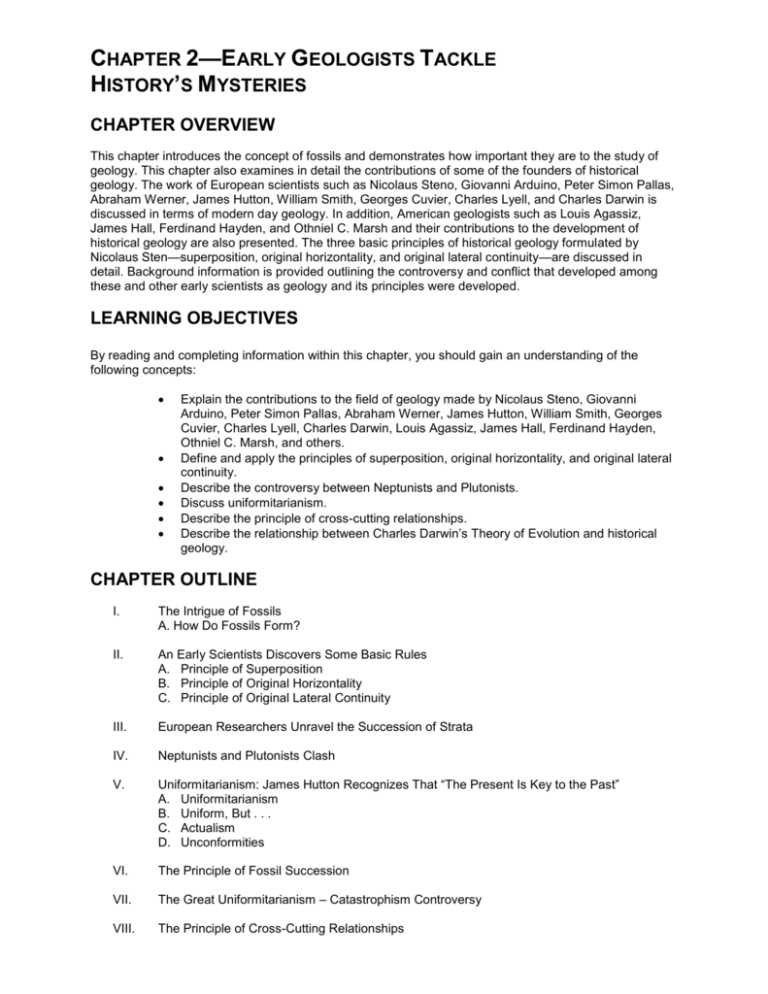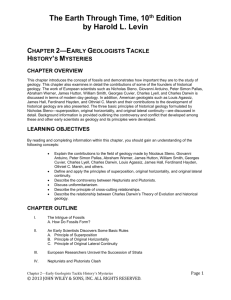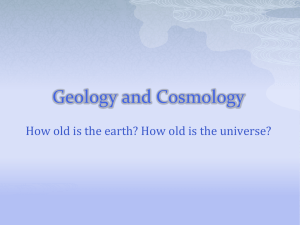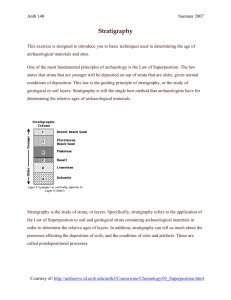Chapter 2—Early Geologists Tackle History`s Mysteries
advertisement

CHAPTER 2—EARLY GEOLOGISTS TACKLE HISTORY’S MYSTERIES CHAPTER OVERVIEW This chapter introduces the concept of fossils and demonstrates how important they are to the study of geology. This chapter also examines in detail the contributions of some of the founders of historical geology. The work of European scientists such as Nicolaus Steno, Giovanni Arduino, Peter Simon Pallas, Abraham Werner, James Hutton, William Smith, Georges Cuvier, Charles Lyell, and Charles Darwin is discussed in terms of modern day geology. In addition, American geologists such as Louis Agassiz, James Hall, Ferdinand Hayden, and Othniel C. Marsh and their contributions to the development of historical geology are also presented. The three basic principles of historical geology formulated by Nicolaus Sten—superposition, original horizontality, and original lateral continuity—are discussed in detail. Background information is provided outlining the controversy and conflict that developed among these and other early scientists as geology and its principles were developed. LEARNING OBJECTIVES By reading and completing information within this chapter, you should gain an understanding of the following concepts: Explain the contributions to the field of geology made by Nicolaus Steno, Giovanni Arduino, Peter Simon Pallas, Abraham Werner, James Hutton, William Smith, Georges Cuvier, Charles Lyell, Charles Darwin, Louis Agassiz, James Hall, Ferdinand Hayden, Othniel C. Marsh, and others. Define and apply the principles of superposition, original horizontality, and original lateral continuity. Describe the controversy between Neptunists and Plutonists. Discuss uniformitarianism. Describe the principle of cross-cutting relationships. Describe the relationship between Charles Darwin’s Theory of Evolution and historical geology. CHAPTER OUTLINE I. The Intrigue of Fossils A. How Do Fossils Form? II. An Early Scientists Discovers Some Basic Rules A. Principle of Superposition B. Principle of Original Horizontality C. Principle of Original Lateral Continuity III. European Researchers Unravel the Succession of Strata IV. Neptunists and Plutonists Clash V. Uniformitarianism: James Hutton Recognizes That “The Present Is Key to the Past” A. Uniformitarianism B. Uniform, But . . . C. Actualism D. Unconformities VI. The Principle of Fossil Succession VII. The Great Uniformitarianism – Catastrophism Controversy VIII. The Principle of Cross-Cutting Relationships Chapter 2—Early Geologists Tackle History’s Mysteries IX. Evolution: How Organisms Change Through Time X. Earth History in America A. Louis Agassiz on Glaciers B. James Hall’s 7.5 Miles of Strata C. Western Geology D. The Dinosaur Rush Chapter 2—Early Geologists Tackle History’s Mysteries KEY TERMS (Pages 11–25) actualism (17): The principle that natural laws governing both past and present processes on Earth have been the same. catastrophism (19): The theory that most features in the Earth were produced by the occurrence of sudden, short-lived, worldwide events. principle of inclusions (20): Fragments within larger rock masses are older than the rock masses in which they are enclosed. Whenever two rock masses are in contact, the one containing pieces of the other will be the younger of the two. principle of cross-cutting relationships (19): This principle states that geologic features such as faults, veins, and dikes must be younger than the rocks or features across which they cut. principle of fossil succession (18): This principle stipulates that the life forms of each age in Earth’s long history are unique for particular periods, that fossils permit geologists to recognize contemporaneous deposits worldwide, and that fossils can be used to assemble scattered fragments in the rock record into a chronologic sequence. principle of original lateral continuity (14): Steno’s principle which states that as originally deposited, strata extend in all directions until they terminate by thinning at the margin of the basin, end abruptly against some former barrier to deposition, or grade laterally into a different kind of sediment. principle of original horizontality (14): Steno’s principle which states that most sedimentary particles settle from fluids under the influence of gravity. The sediment must then be deposited in layers that are nearly horizontal and parallel to the surface on which it is accumulating. principle of superposition (13): Steno’s principle which states that in any sequence of undisturbed strata, the oldest layer is at the bottom and successively higher layers are successively younger. stratigraphy (14): The study of layered rocks, including their texture, composition, arrangement, and correlation from place to place. unconformity (17): A surface separating an overlying younger rock formation from an underlying formation and representing an episode of erosion or nondeposition. Because unconformities represent a lack of continuity in deposition, there are gaps in the geologic record. Chapter 2—Early Geologists Tackle History’s Mysteries MULTIPLE-CHOICE QUESTIONS 1. The principle which stipulates that in any sequence of undisturbed strata, the oldest layer is at the bottom and successively higher layers are successively younger is the a. principle of superposition. c. principle of original horizontality. b. principle of original lateral continuity. d. principle of stratigraphy. 2. Nicholas Steno formulated all of these basic principles except a. principle of original horizontality. c. principle of superposition. b. principle of uniformitarianism. d. principle of original lateral continuity. 3. His method of interpreting rock exposures by observing present day processes was given the phrase “the present is the key to the past.” a. Charles Lyell c. William Smith b. James Hutton d. Baron Cuvier 4. The stratigraphic relationship where flat-lying strata overlies the eroded edges of inclined older strata is called a. unconformity. c. disconformity. b. nonconformity. d. angular unconformity. 5. The principle that fossils can be used to correlate strata from different localities that separate strata into different ages is called a. Stratigraphic Succession. c. Lateral Continuity. b. (Fossil) Succession. d. Walther’s Law. 6. The observation that an igneous intrusion or fault that intrudes or cuts a younger rock is called the principle of a. lateral continuity. c. cross-cutting relationships. b. original horizontality. d. superposition. 7. The principle that states the past history of the Earth can be interpreted in accordance with our knowledge of natural processes still operating today is called a. biologic continuity. c. law of uniformitarianism. b. law of superposition. d. law of biologic succession. 8. The concept that the history of life as recorded in the fossil record was marked by sudden periods of continental floods or abrupt crustal upheavals is called a. diastrophism. c. uniformitarianism. b. Plutonism. d. catastrophism. 9. This noted geologist proposed the principle of cross-cutting relationships and inclusions. a. Nicoleus Steno c. James Hutton b. William Smith d. Charles Lyell 10. The principle that an igneous intrusion or fault must be younger than the rocks it intrudes or cuts is termed a. superposition. c. original horizontality. b. lateral continuity. d. cross-cutting relationships. 11. This early Swiss paleontologist became a Harvard University professor, founding the Harvard Museum of Comparative Zoology, and also offered his “Ice Age” hypothesis for the Pleistocene. a. Neils Stensen c. James Hutton b. Louis Agassiz d. John Strachey 12. This principle applies not only to rock bodies, but also to geologic structures, i.e., faults and unconformities that have been penetrated by another rock body. a. catastrophism c. lateral continuity b. original horizontality d. cross-cutting relationships Chapter 2—Early Geologists Tackle History’s Mysteries 13. Louis Agassiz’s studies of the “Ice Age” became recognized as the main event of the Pleistocene Epoch. The Ice Age is recognized as beginning about 1.5 years ago and ending ______________________ years ago. a. 8,000-10,000 c. 15,000-20,000 b. 10,000-15,000 d. 35,000-50,000 14. Two of the most important contributors to early studies of the Grand Canyon that would eventually led to its prominence within the national park system. a. Edwin D. Cope, Othneit C. Mash c. Russell Wallace, Edwin D. Cope b. Ferdinand V. Hayden, John Powell d. Leopold Cuvier, Alexander Brongniart 15. This prominent geologist published Theory of the Earth in which he discussed the significance of unconformities and what they represented. a. Alfred Wallace c. James Hall b. John Playfair d. James Hutton 16. This early geologists formulated the following three basic principles of historical geology superposition, original horizontality, and original lateral continuity. a. James Hall d Nicholas Steno b. Charles Lyell e. James Hutton c. John Strachey 17. Giovanni Arduino classified mountains according to their most abundant rock type. His secondary mountains were constructed of a. clay, sand, and clay beds. c. crystalline rocks, igneous, metamorphic rocks. b. igneous, metamorphic sequences. d. layered, consolidated fossilerous rocks. 18. These early two paleontologists exploited dinosaur fossils in the western United States. Their endeavors led to thousands of specimens for studies in museums. a. John Strachey, Nicholus Steno c. Edwin D. Cope, Othniel C. Marsh b. John Powell, Ferdinand V. Hayden d. superposition 19. Steno’s three principles are basic to the geology study of a. paleontology. c. stratigraphy. b. actualism. d. superposition. 20. This famous geologist is quoted as saying, “The present is the key to the past.” a. John Playfair c. Charles Lyell b. Alfred Werner d. James Hutton Chapter 2—Early Geologists Tackle History’s Mysteries FILL IN THE BLANK 1. The Danish physician who proposed the principles of superposition, original horizontality, and original lateral continuity is . 2. The English geologist who established the Principles of Cross-Cutting Relationships and the Principle of Inclusions is . 3. Founder of the Harvard Museum of Comparative Zoology, his early glacial studies of the Alps promoted the glaciation of North America and Eurasia . 4. __________________________ is the study of layered rocks, including their texture, composition, arrangement, and correlation from place to place. 5. _______________________ ____________________, an Edinburgh physician and geologist, saw the Earth as a dynamic, ever-changing globe; a view opposed to Werner’s static concept of the Earth. 6. ___________________ is the principle that natural laws governing both past and present processes on the Earth have been the same. 7. _________________ __________________, an English surveyor and engineer was the individual whose work led to the formulation of principle of fossil succession. 8. Along a granite-sandstone rock contact line it is common for fragments of one rock to appear on the other. These fragments are called ______________________. 9. George Leopold Cuvier, after studying fossils in several rock groups, concluded that the history of life was marked by frightening catastrophes involving flooding of the continents and crustal upheavals. This view is known as ______________________________. 10. ____________________ are an extinct group of cephalopods related to the living, chambered nautilus. 11. __________________ ___________________ was an influential, eloquent, and enthusiastic lecturer who published the first great mineralogy textbook. 12. In developing his theory of evolution, Charles Darwin secured an unpaid position on the _____________________ for a five-year mapping expedition around the world to observe and study a wide variety of living things. 13. In addition to Charles Darwin, __________________ _________________ also contributed to the theory of natural selection. 14. ______________________ _____________________ became the first professor of paleontology at Yale University and later founded the Peabody Museum of Natural History. 15. Charles Darwin published his findings on natural selection in 1859 in his book _________________ _______________________________. Chapter 2—Early Geologists Tackle History’s Mysteries TRUE/FALSE 1. James Hutton provides the basic principles of superposition, original horizontality, and original lateral continuity. 2. The principle of superposition states that sediment is deposited in layers that are originally horizontal. 3. Professor Abraham Werner an influential and eloquent lecturer at Freiburg Mining Academy in Germany insisted that all rocks were deposited or precipitated from a great ocean that once enveloped the entire planet. 4. The principle of actualism states that the past history of our Earth can be explained by observing events today. 5. William Smith developed the principle of fossil succession which states that the natural laws governing both past and present processes on the Earth have been the same. 6. Sir Charles Lyell, an English geologist, developed the principle of cross-cutting relationships. 7. The basis of Charles Darwin’s theory of evolution is natural selection. 8. Louis Agassiz, a Swiss paleontologist, founded the Harvard Museum of Comparative Zoology. 9. James Hall, a brilliant geologist and paleontologist, was appointed director of New York’s first geological survey. 10. Edwin Cope led several geologic and geographic surveys of the western United States and directed the U.S. Geologic survey. Chapter 2—Early Geologists Tackle History’s Mysteries ANSWER KEY Multiple Choice Fill Ins 1. 2. 3. 4. 5. 6. 7. 8. 9. 10. 11. 12. 13. 14. 15. 16. 17. 18. 19. 20. 1. 2. 3. 4. 5. 6. 7. 8. 9. 10. 11. 12. 13. 14. 15. a b b d b c c d d d b d a b d d d c c d Nicholaus Steno Charles Lyell Louis Agassiz Stratigraphy James Hutton Actualism William Smith inclusions catastrophies Ammonites Abraham Werner HMS Beagle Alfred Wallace Othniel Marsh On the Origin of Species True/False 1. F 2. F 3. T 4. F 5. F 6. T 7. T 8. T 9. T 10. F Chapter 2—Early Geologists Tackle History’s Mysteries RESPONSES TO QUESTIONS ACCOMPANYING SELECTED FIGURES FIGURE 2–4 (p. 14) By superposition, the youngest stratum visible in the photograph would be at the top of the sequence of strata exposed in the bluff above the river, where it turns off to the right. FIGURE 2–6 (p. 15) The source area lay to the west. Because of their larger size and weight, sand grains were deposited near the shoreline. Finer particles were carried in suspension farther into the basin of deposition and were ultimately deposited, providing that graduation from nearshore sandstones to offshore shales. FIGURE 2–12 (p. 21) The sandstone in (A) is younger than 150 million years but older than 100 million years. Because the sandstone in (B) occurs as inclusions within the granitic body, it must have been there before the intrusion and is hence older than the granitic body. It also is older than the shale that lies superpositionally above it. FIGURE 3–2 (p. 30) The Devonshire strata contained a fossil assemblage characteristic of rocks elsewhere in Europe that were superpositionally higher (hence, younger) than those described as Silurian in southern Wales by Murchison. FIGURE 3–7 (p. 37) The stratum beneath the ash must be older than 453.7 million years. FIGURE 3–10 (p. 38) If a graph were prepared showing how much sand passed through an hourglass in each unit of time, the graph would display an inclined straight line, indicating that the amount of original material lost from the top of the hourglass to the lower half is the same during each unit of time. Because the amount of original radioactive material that is lost diminishes with time, the curve on a graph showing radioactive decay would consist of an inclined concave curve. FIGURE 3–11 (p. 39) The age of a rock having a 207Pb/ 206of 0.15 would be 2.6 billion years old.









